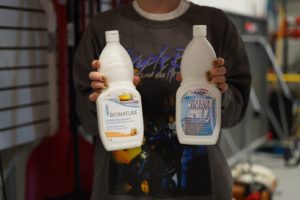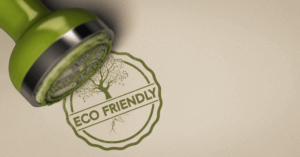In high-traffic areas where cleaning is frequent, choosing the right products becomes important, as inadequate products can, over time, harm the health of the people who handle them.
In recent years, many organizations have considered moving away from traditional products in favor of eco-friendly options. But on the ground, doubts remain: do eco-friendly cleaning products really clean just as well?
In reality, eco-responsible products can be very effective as long as they’re chosen carefully and used correctly.

What’s in cleaning products?
Traditional cleaning products:
Conventional cleaners often rely on ingredients derived from petrochemicals: chlorinated solvents, ammonia, phosphates, synthetic fragrances.
These formulas are known for their strength. But they can irritate the eyes, skin, and lungs. And their environmental impact is far from negligible, especially when they end up in the sewage system.
Eco-friendly cleaning products:
Eco-responsible alternatives are designed differently. They use plant-based cleaning agents. They are often biodegradable and formulated without artificial fragrances or dyes. Their pH is gentler, which means they’re less irritating to those handling them.

Do they actually clean well?
The short answer: yes. But there’s a catch. Eco-friendly products work very well if used properly. Dosage, surface type, application frequency, etc. They’re not miracle solutions, but they are effective tools when used correctly.
Here’s what we see in the field:
-
Effectiveness: For regular cleaning, quality eco products offer results comparable to traditional ones.
-
Environment: Less pollution, fewer toxic residues, reduced environmental risks.
-
Versatility: Some eco-cleaners can be used on multiple surfaces, simplifying supply management.
-
Safety: Fewer irritations, fewer allergic reactions. A real plus for employee health.
👉 Read also: Exposure to cleaning products: what are the risks for those who use them daily?
What about the budget?
Yes, it’s true: some eco-friendly products cost more per unit. But they’re often more concentrated. Meaning: less waste, more savings in the long run.
And there are indirect benefits too: lower risks from product handling and a stronger brand image.
Key takeaway
Switching cleaning products isn’t a trend. It’s a shift toward more sustainable and responsible practices. And today, it’s entirely possible to combine effectiveness, safety, and environmental awareness.
Need advice on choosing the right products for your commercial spaces? We can help.